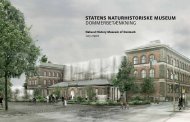Campus og studiemiljø - Bygningsstyrelsen
Campus og studiemiljø - Bygningsstyrelsen
Campus og studiemiljø - Bygningsstyrelsen
Create successful ePaper yourself
Turn your PDF publications into a flip-book with our unique Google optimized e-Paper software.
in terms of issues addressed and in terms<br />
of how knowledge is applied. Therefore,<br />
in this perspective the university is also<br />
dependent on being an open meeting place<br />
for different currents of thought – well integrated<br />
in the city.<br />
In the postscript to the book ‘The University<br />
and the City’, 1988, editor Thomas<br />
Bender writes about the differences and<br />
similarities between universities and the<br />
city. The city, he believes, is an “open heter<strong>og</strong>eneity”.<br />
The heter<strong>og</strong>eneity refers to the<br />
multiplicity and the inner contradictions<br />
inherent in any complex institution. The<br />
university is a “semi-cloistered heter<strong>og</strong>eneity”.<br />
The semi-cloisteredness represents a<br />
delicate balance between the university’s<br />
inner world (the cloister-like closedness)<br />
and participation in the exterior context.<br />
The interface between the university and<br />
its surroundings becomes an important<br />
spatial aspect.<br />
two traditions<br />
Two traditions run through 800 years of<br />
university building history: The internalist<br />
tradition encompasses the college, the<br />
American campus and what might be<br />
termed the external university. The externalist<br />
tradition includes universitas, the<br />
institutional university and the city campus.<br />
These traditions are very much alive, both<br />
because of buildings that are still in use and<br />
because of points of view that are passed on<br />
in new buildings. I will alternately describe<br />
the internalist and the externalist tradition<br />
through a series of examples.<br />
the college<br />
The college was established as a foundation<br />
by means of donated funds during the<br />
Middle Ages. It had statutes that governed<br />
the life of teachers and students. Collegio<br />
di Spagna in Bol<strong>og</strong>na dating back to 1367 is<br />
often considered the first specialised university<br />
building in Europe. It is clearly modelled<br />
on the monastery. A closed wall surrounds<br />
a square two-storey building around an inner<br />
courtyard. Here, teachers and students<br />
sleep, eat and study in a world of its own. At<br />
one end of the courtyard there is a church,<br />
exactly as the church by the cloister.<br />
The tradition lives on in English colleges.<br />
At Oxford, college areas are spread all<br />
over the city with houses and classrooms<br />
around large quadrangles, often with a<br />
church at one side. Cambridge is more<br />
divided into a row with the college on one<br />
side and the city on the other – the contrast<br />
known as ‘town and gown’.<br />
“ de tidligste universiteter var ikke fysisk forankrede<br />
institutioner, de kunne faktisk flytte sig fra by til by med<br />
deres lille b<strong>og</strong>samling. de havde ingen specialbyggede<br />
lokaler, men lejede sig ind i byens almindelige huse / early<br />
universities were not physically anchored institutions, they<br />
could actually move from one city to another with their small<br />
collection of books. they did not have any purpose-built<br />
rooms, but rented space in ordinary houses in the town<br />
universitas<br />
Universitas means ‘guild’, in this case the<br />
guild of university teachers. Early universities<br />
were not physically anchored institutions,<br />
they could actually move from one<br />
city to another with their small collection of<br />
books. They did not have any purpose-built<br />
rooms, but rented space in ordinary houses<br />
in the town. Albeit preferably in one particular<br />
part of the city, just as other guilds belonged<br />
to their particular streets. The university’s<br />
street might be called ‘School Street’,<br />
‘Book Street’ or something similar. In central<br />
Copenhagen, it was called ‘Studiestræde’<br />
tre perspektiver: Historisk / tHree perspeCtives: HistoriCal<br />
– Study Alley. For large gatherings and formal<br />
occasions, the local church was used.<br />
One important aspect of universitas was that<br />
students, just as the teachers, formed their<br />
own ‘guilds’, or fraternities, and that they<br />
were clearly independent of and partly separate<br />
from the college.<br />
the campus university<br />
The campus university is originally an American<br />
tradition. The earliest reference to the<br />
concept is found in a letter from 1774 about<br />
the Princeton university area. The tradition<br />
of American universities was brought over by<br />
the first English colonialists and had its origin<br />
in the colleges of Oxford and Cambridge. In<br />
America, there were no towns in the Middle<br />
Ages. Furthermore, the universities were often<br />
established at ‘the frontier’, as their primary<br />
task was to educate priests. It was considered<br />
particularly important to carry out missionary<br />
work amongst the Indians. There was<br />
no basis for encircled courtyards here. The<br />
square became a ‘yard’ or a ‘ground’. Following<br />
independence, the campus concept spread<br />
and ended up denoting not just the lawn in<br />
front of the main building, but the entire university<br />
area. Part of the college tradition lived<br />
on in the idea that the university should take<br />
responsibility for the student’s entire life,<br />
even including accommodation and spare<br />
time, e.g. sports. The university stood ‘in loco<br />
parentis’ i.e. in the parents’ place.<br />
the institutional university<br />
The institutional university on the European<br />
continent belonged more to the universitas<br />
traditition. As the university grew and had<br />
more purpose-built buildings – first anatomy<br />
theatres and astronomy observatories and<br />
then, from the 19 th century on, an increasing<br />
number of specialised scientific institutions<br />
– it was no longer possible to keep the university<br />
area in one place. It became necessary<br />
to use plots of land that could be acquired<br />
around the city, which resulted in a more or<br />
less spread-out localisation, well-integrated<br />
in the city. In the course of the 19 th century,<br />
new main buildings for academic ceremonies<br />
were constructed in many places. They<br />
also became a means of asserting the place of<br />
traditional humanities subjects at the university.<br />
And the seminar room became humanities’<br />
answer to the laboratory of science.<br />
13

















